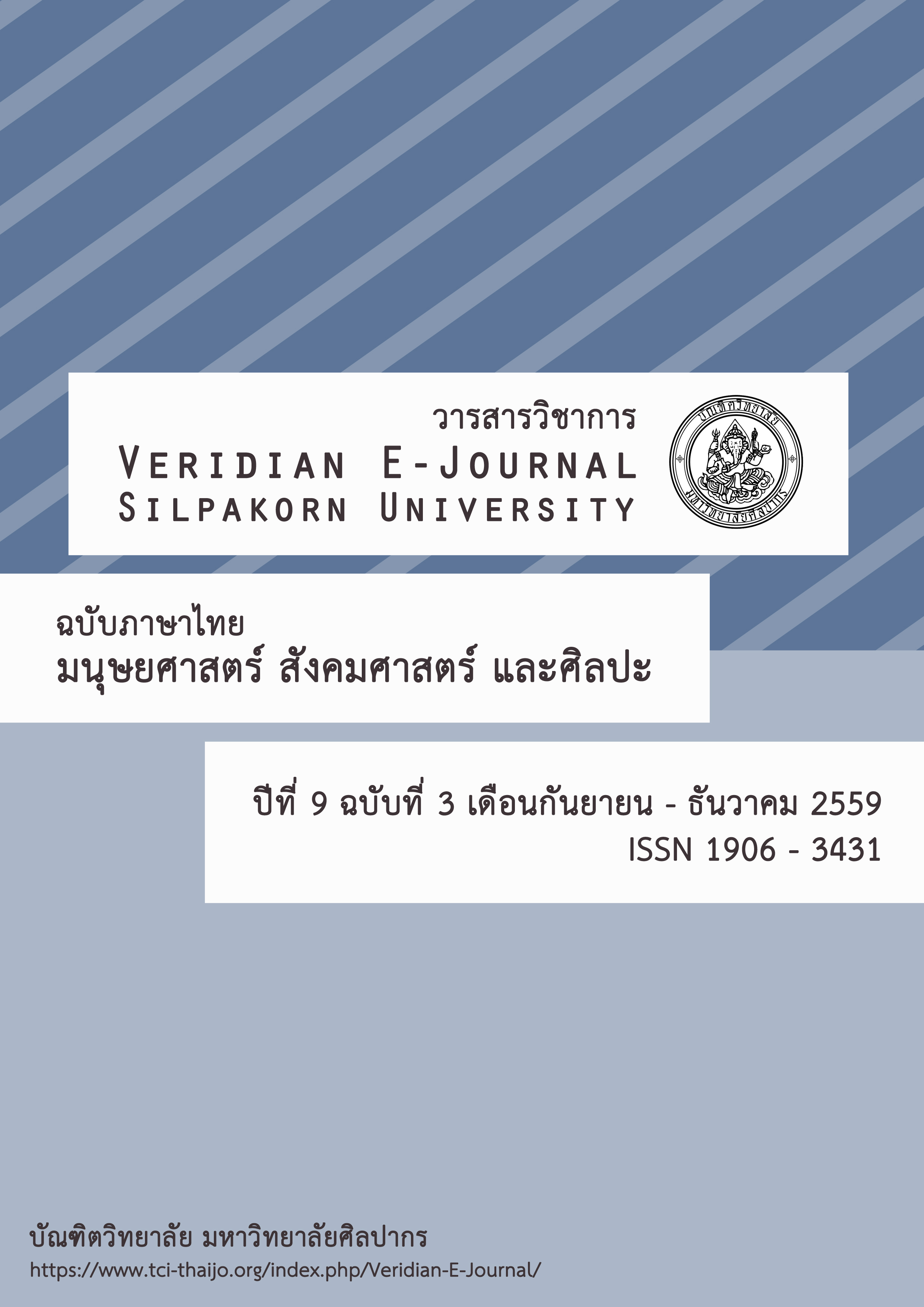การพัฒนาแบบสอบวินิจฉัยจุดบกพร่องทางการเรียนวิชาคณิตศาสตร์ เรื่อง พหุนาม ระดับชั้นมัธยมศึกษาปีที่ 1
Main Article Content
Abstract
การวิจัยครั้งนี้มีวัตถุประสงค์เพื่อ 1) พัฒนาแบบสอบวินิจฉัยจุดบกพร่องทางการเรียนวิชาคณิตศาสตร์ เรื่อง พหุนาม ระดับชั้นมัธยมศึกษาปีที่ 1 2) หาคุณภาพแบบสอบวินิจฉัยจุดบกพร่องทางการเรียนวิชาคณิตศาสตร์ เรื่อง พหุนาม ระดับชั้นมัธยมศึกษาปีที่ 1 กลุ่มตัวอย่างที่ใช้ในการวิจัยครั้งนี้ เป็นนักเรียนระดับชั้นมัธยมศึกษาปีที่ 1 โรงเรียนเสนา“เสนาประสิทธิ์” ประจำปีการศึกษา 2558 จำนวน 231 คน ซึ่งได้มาโดยวิธีการสุ่มแบบหลายขั้นตอน การดำเนินการสร้างแบบสอบเริ่มจากการพัฒนาแบบสอบเพื่อสำรวจจุดบกพร่องทางการเรียนเรื่อง พหุนาม ชนิดอัตนัยเติมคำ เพื่อค้นหาจุดบกพร่องในการเรียนพหุนาม หลังจากนั้นนำมาสร้างเป็นแบบสอบวินิจฉัย โดยนำคำตอบที่นักเรียนตอบผิดในแบบสอบเพื่อสำรวจมาสร้างเป็นตัวลวง ได้แบบสอบวินิจฉัย 3 ฉบับ ฉบับที่ 1 ความรู้เบื้องต้นเกี่ยวกับพหุนาม ฉบับที่ 2 การบวกและการลบพหุนาม และฉบับที่ 3 การคูณและการหารพหุนาม นำไปทดสอบ 2 ครั้ง ทดสอบครั้งที่ 1 เพื่อวิเคราะห์ข้อสอบรายข้อและปรับปรุงข้อสอบ ทดสอบครั้งที่ 2 เพื่อหาคุณภาพแบบสอบแต่ละฉบับและวิเคราะห์จุดบกพร่องของนักเรียน
ผลการวิจัยพบว่า แบบสอบวินิจฉัย 3 ฉบับ มีค่าความตรงเชิงเนื้อหาของแบบสอบโดยวิธีของ โรวิเนลลีและแฮมเบิลตันมีค่าเฉลี่ยเท่ากับ 1.00 ทุกข้อ แสดงว่าแบบสอบทั้ง 3 ฉบับเป็นแบบสอบที่มีคุณภาพสามารถวัด เรื่อง พหุนามได้จริงและสามารถแบ่งนักเรียนเป็นกลุ่มรอบรู้และไม่รอบรู้ได้ มีค่าความยากของแบบสอบตั้งแต่ 0.66 - 0.78 และค่าอำนาจจำแนกของแบบสอบตั้งแต่ 0.49 - 0.85 ส่วนค่าความเชื่อมั่นของแบบสอบแต่ละฉบับ ซึ่งคำนวณโดยใช้สูตรไบโนเมียลของโลเวทท์มีค่า 0.81, 0.77 และ 0.80 ตามลำดับ สำหรับคะแนนจุดตัดของแบบสอบทั้ง 3 ฉบับ มีค่าเป็น 7, 5 และ 6 ตามลำดับ จุดบกพร่องของนักเรียนในการเรียน เรื่อง พหุนาม ที่พบมากที่สุด คือ นักเรียนดูดีกรีตัวที่น้อยที่สุดเป็นจำนวนพจน์ของ พหุนาม คิดเป็นร้อยละ 15.58 นักเรียนหาร 8x2 ผิด (หารสัมประสิทธิ์ผิด) คิดเป็นร้อยละ 13.85 และนักเรียนบวกตัวเลขผิด คิดเป็นร้อยละ 12.12 ตามลำดับ
The purpose of this research were (1) the development of a mathematics diagnostic test for polynomials at the Matthayom Sueksa One level. The researcher also determines (2) the quality of this mathematics diagnostic test for polynomials. Using the multistage random sampling technique, the researcher selected a sample population consisting of 231 Matthayom Sueksa One students enrolled in the academic year 2015 at Sena “Senaprasit” School. In the first step the researcher conducted a survey of student skills in manipulating polynomials in order to find deficient skills in this area of mathematics. To this end, the researcher constructed a subjective diagnostic test in which answers were given by the students by means of filling in blanks. In the next step, a diagnostic test was constructed using incorrect answers given by the students in the first test. In this test, the alternatives consisted of one correct or best alternative with the other alternatives being incorrect or inferior alternatives called “distractors,” i.e., the wrong answers from the first test in this case. In the succeeding stage, the researcher then constructed three diagnostic tests. The first test concerned basic knowledge of polynomials; the second test involved the addition and subtraction of polynomials; and the third test dealt with the multiplication and division of polynomials. The three tests were administered twice each. The purpose of the first test was to analyze the items included in the tests and to use the results in improving the tests. The second test was used for determining the quality of the test and to analyze student deficiencies in manipulating polynomials.
Findings are as followed: Using the index of item-objective congruence developed by Rovinelli and Hambleton, the researcher determined that all three diagnostic tests showed content validity at a value of 1.00 for all items. This means that all three tests showed quality such that they could be used for testing skills in manipulating polynomials, thereby allowing the separation of the students into two groups. While the first group commanded a full set of skills for manipulating polynomials, the second group did not command a full set of skills. The difficulty of the test was computed to range from 0.66 to 0.78. The discriminatory power of the test was determined to range from 0.49 to 0.85. Applying the binomial distribution method of Hubert T. Lovett, the researcher established that the validity of the three tests was 0.81, 0.77, and 0.80, respectively. The cut-off scores for the three tests were 7, 5, and 6, respectively. Findings show that in descending order the deficient skills of the students in the study of polynomials were as follows: At the highest level, students mistakenly took the term with the lowest degree as the degree of the polynomial instead of taking the term with the highest degree as the degree of the polynomial (15.58 percent). At the next level, students incorrectly divided 8x2 (incorrect coefficient division) at 13.85 percent. At the lowest level, students incorrectly added polynomial terms (12.12 percent).
